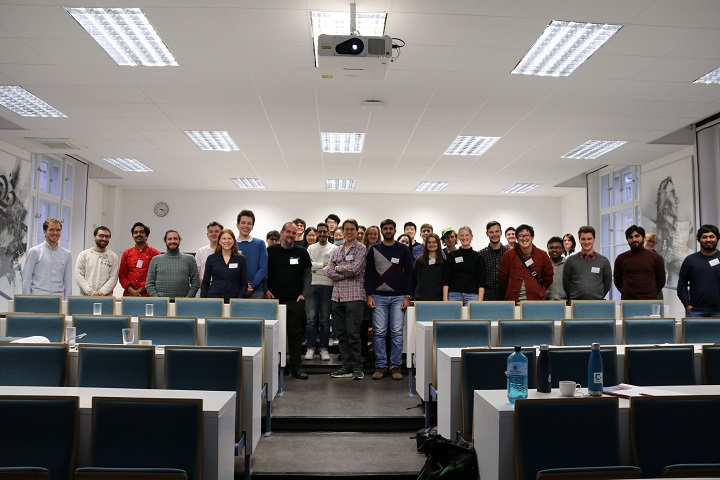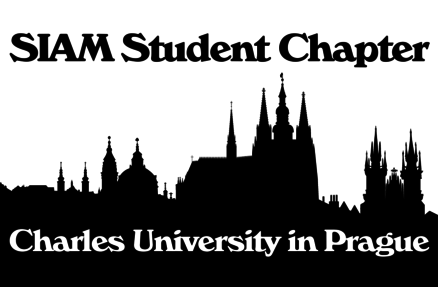Naše akce - Seminář SIAM SC - Další akce
Studentský workshop o aplikované matematice (SWAM)
Kdy: 17/11/2022 09:00 - 19/11/2022 14:00
Kde: Sokolovská 49/83 & Malostranské nám. 2/25

Studentský workshop o aplikované matematice je pořádaný za podpory aliance 4EU+. Výdaje pro omezený počet studentů z Kodaňské univerzity a Univerzity Heidelberg budou financovány aliancí 4EU+. Workshop je určen především pro magisterské a doktorské studenty. Jeho hlavním cílem je zprostředkovat setkání studentů přírodních věd, inženýrských oborů a teoretické i aplikované matematiky a vytvořit prostředí pro sdílení nápadů z různých perspektiv a navázání společné řeči se zkušenějšími výzkumníky pro případnou hladkou mezinárodní mezioborovou spolupráci.
I pokud jste se nestihli registrovat na celý workshop, můžete se zúčastnit celého dne workshopu či libovolné přednášky jak pozvaných přednášejících, tak mezinárodních studentů (viz program včetně abstraktů níže).
___________________________________________________
Napsali o nás
Zpráva před worshopem zde.
Zpráva po worshopu zde.
___________________________________________________
Součástí workshopu bude studentský meet-up (středa), společná večeře (čtvrtek) a procházka městem (pátek). Podrobnější program bude zveřejněn na této stránce v průběhu listopadu. Kromě přednášek pozvaných profesorů (viz níže), budou mít studenti možnost prezentovat svou práci v krátké prezentaci o minimální délce 15 minut a maximální délce 30 minut včetně diskuse. Deadline pro podání přihlášky je 17. října 2022. Účast je zdarma, ale počet účastníků je omezen.
Prosíme účastníky, kteří mají zájem na workshopu prezentovat svou práci, aby abstrakt své přednášky poslali na e-mail
studentworkshop@4euplus.eu do 17. října 2022. Abstrakt posílejte v PDF formátu a jeho text přizpůsobte instrukcím v šabloně, kterou naleznete níže v příloze.
Máte-li jakékoliv dotazy nebo pokud potřebujete pomoct (např. v případě problémů se šablonou abstraktu), neváhejte nás kontaktovat na našem e-mailu.
Kontakt: studentworkshop@4euplus.eu
___________________________________________________
Seznam přednášejících (bude aktualizován):
Jakob Zech (Heidelberg University)
Melina Freitag (University of Potsdam)
Rolf Poulsen (University of Copenhagen)
Cristóbal Bertoglio (University of Groningen)
Martin Stoll (Chemnitz University of Technology)
Jens Saak (Max Planck Institute for Dynamics of Complex Technical Systems)
Jan Papež (Akademie věd České republiky)
Roman Neruda (Akademie věd České republiky)
Petr Minařík, Ondřej Hroch (Keen Software House)
Oldřich Semerák (Univerzita Karlova)
Friedemann Kemm (BTU Cottbus-Senftenberg)
___________________________________________________
Jakob Zech – Large Scale Bayesian Inversion: Sparse-Grid and Transport Methods
Abstrakt:
Bayesian inference provides a rigorous framework to learn unknown parameters from noisy data. As such it has become a ubiquitous tool in modern machine learning and applied mathematics. From a practical perspective, it requires the approximation of high-dimensional integrals. Common approaches to do so include (i) sampling methods and (ii) specifically devised deterministic quadrature rules. In this talk I will discuss transport based sampling and sparse-grid quadrature as two instances of such algorithms. Additional to explaining how they can be used to perform parameter inference, I will give some insight into why these methods can deal with high dimensionality for certain PDE driven inverse problems.
Rolf Poulsen – Tools for Modern Computational Finance
Abstract:
Under very general conditions – but for surprisingly subtle reasons – a key part finding a sensible price for any financial contract is the calculation of expected values. After briefly reviewing the arbitrage-free pricing of a call option in the Black-Scholes model, I describe some tools used in modern computational finance. More specifically, but deliberately teasingly, this will involve some of the following concepts and names:
Under very general conditions – but for surprisingly subtle reasons – a key part finding a sensible price for any financial contract is the calculation of expected values. After briefly reviewing the arbitrage-free pricing of a call option in the Black-Scholes model, I describe some tools used in modern computational finance. More specifically, but deliberately teasingly, this will involve some of the following concepts and names:
- Scripting languages and smart contracts.
- Fourier inversion and the return of complex analysis
- Sobol, Longstaff-Schwartx, Craig-Sneyd
- Automatic adjoint differentiation
- Automatic adjoint differentiation
- Differential machine learning
Abstrakt:
In this talk we briefly review some basic PDE models that are used to model phase separation in materials science. They have since become important tools in image processing and over the last years semi-supervised learning strategies could be implemented with these PDEs at the core. The main ingredient is the graph Laplacian that stems from a graph representation of the data. This matrix is large and typically dense. We illustrate some of its crucial features and show how to efficiently work with the graph Laplacian. In particular, we need some of its eigenvectors and for this the Lanczos process needs to be implemented efficiently. Here, we suggest the use of the NFFT method for evaluating the matrix vector products without even fully constructing the matrix. We illustrate the performance on several examples.
Melina Freitag – From Models to Data and Back - An Introduction to Data Assimilation Algorithms
Melina Freitag – From Models to Data and Back - An Introduction to Data Assimilation Algorithms
Abstract:
Data assimilation is a method that combines observations (e.g. real world data) of a state of a system with model output for that system in order to improve the estimate of the state of the system. The model is usually represented by discretised time dependent partial differential equations. The data assimilation problem can be formulated as a large scale Bayesian inverse problem. Based on this interpretation we derive the most important variational and sequential data assimilation approaches, in particular three-dimensional and four-dimensional variational data assimilation (3D-Var and 4D-Var), and the Kalman filter. The final part reviews advances and challenges for data assimilation.
Cristóbal Bertoglio – Inverse problems in blood flow modeling
Abstrakt:
Mathematical and computational modeling of the cardiovascular system is increasingly providing non-invasive alternatives to traditional invasive clinical procedures. Moreover, it has the potential for generating additional diagnostic markers. In blood flow computations, the personalization of spatially distributed models is a key step which relies on the formulation and numerical solution of inverse problems using clinical data. In the last years, the development and application of inverse methods has rapidly expanded most likely due to the increased availability of data in clinical centers and the growing interest of modelers and clinicians in collaborating. In this talk I will present some of the inverse problems in blood flows formulated in our group, in particular from data coming from Magnetic Resonance Imaging and including fluid-structure interaction models.
Jens Saak – A journey to digital twins of machine tools
Abstrakt:
Industry 4.0 requires the design and control of complex models, which generally need to be fitted to measurement data and made suitable for real-time control applications; e.g., digital twins and digital shadows serve as computer-based representations of machines and processes during the entire product cycle. In this talk, we will evaluate strategies for modeling and model order reduction of machine tools, i.e. machines that are used to build (parts of) machines. Thermo-mechanical models for the machine tools feature a couple of challenges for both modeling and order reduction techniques:
- To limit the effort, usually stationary elasticity is coupled with transient heat equations, rendering the full model a differential algebraic equation.
- While the heat distribution and elastic deformation can be modeled by linear partial differential equations, some components like bearings and guide shoes feature nonlinearities that are crucial for correct representation of the machine behavior.
- Modern machine tools feature up to 6 axes along which parts can be moved for optimal placement of the tool relative to the work-piece. On each of these axes, two parts of the machine are moving relative to each other making the entire model time-varying. Over the recent decade, we have worked out methods to address all these challenges and created an automated workflow for practitioners using both proprietary and open-source tools to create and use the desired digital representation for each task.
Jan Papež - Can a computed result be relied on?
Abstrakt:
Real-world applications often give rise to complex and challenging problems that can only be solved numerically. In order to reduce the complexity of the problem and allow us to get an approximation within the given time using available computational resources, one has to consider some simplifications, which typically introduce various errors. We should then ask how accurate is the computed approximation and whether it can be used for the original application. This can be answered by so-called a posteriori error estimates that are based on the properties of the problem to be solved and evaluated from the computed approximation. In the talk, we will present some error estimates for numerical solution of partial differential equations.
Roman Neruda – Adversarial examples: how safe are machine learning models
Abstrakt:
Adversarial examples are special inputs to machine learning models intentionally designed to cause the model to make a mistake. They represent an important issue concerning security and generalization capabilities of models deployed in practical applications. In the talk we will present several approaches of adversarial attacks for image classifiers, and sketch possible defense strategies.
Petr Minařík – Realtime Interactive Volumetric Water Simulation
Abstrakt:
Water, water everywhere. This talk will focus on illustrating a modern approach to water simulation in video games. This novel solution provides realistic simulation, during real time play, and as a mechanic of play. We will share working examples of our solution, including an algorithm that illustrates our core concepts.
Oldřich Semerák – On the marmoreally beautiful and yet unlovely sides of Einstein equations
Abstrakt:
On January 24, 1938, Albert Einstein wrote to Cornelius Lanczos: “I began with a skeptical empiricism more or less like that of Mach. But the problem of gravitation converted me into a believing rationalist, that is, into someone who searches for the only reliable source of Truth in mathematical simplicity.” Mathematics (Riemann-type geometry) played a fundamental role in Einstein’s quest for the new theory of gravitation. We will shortly recall when and how geometry entered the game, why the left-hand (“geometrical”) side of the Einstein equations is so elegant, and why their right-hand (“physical”) side likely has to remain unlovely.
Friedemann Kemm – How to prepare a scientific presentation
Friedemann Kemm – How to prepare a scientific presentation
Abstrakt:
This will be a talk about talks. Giving a presentation in mathematics or science in general shares some issues with presenting science in written form and with giving a public speech in general. Especially the latter is often forgotten when it comes to presenting on a conference in science and mathematics. We will discuss some general strategies how to convey a message in a public talk and some techniques in preparing slides for a presentation that will be helpful in this context.
This will be a talk about talks. Giving a presentation in mathematics or science in general shares some issues with presenting science in written form and with giving a public speech in general. Especially the latter is often forgotten when it comes to presenting on a conference in science and mathematics. We will discuss some general strategies how to convey a message in a public talk and some techniques in preparing slides for a presentation that will be helpful in this context.
Workshop poster ABSTRACT_TEMPLATE Conference booklet Workshop schedule group_photo group_photo_small


